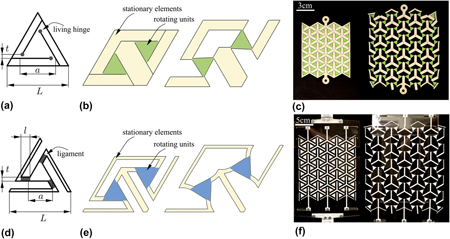Crossref Citations
This article has been cited by the following publications. This list is generated based on data provided by
Crossref.
Celli, Paolo
McMahan, Connor
Ramirez, Brian
Bauhofer, Anton
Naify, Christina
Hofmann, Douglas
Audoly, Basile
and
Daraio, Chiara
2018.
Shape-morphing architected sheets with non-periodic cut patterns.
Soft Matter,
Vol. 14,
Issue. 48,
p.
9744.
Wang, Bing
Tan, Xiaojun
Zhu, Shaowei
Chen, Shuai
Yao, Kaili
Xu, Peifei
Wang, Lianchao
Wu, Huaping
and
Sun, Yuguo
2019.
Cushion performance of cylindrical negative stiffness structures: Analysis and optimization.
Composite Structures,
Vol. 227,
Issue. ,
p.
111276.
Iniguez-Rabago, Agustin
Li, Yun
and
Overvelde, Johannes T. B.
2019.
Exploring multistability in prismatic metamaterials through local actuation.
Nature Communications,
Vol. 10,
Issue. 1,
Liu, Lu
Qiao, Chuan
An, Haichao
and
Pasini, Damiano
2019.
Encoding kirigami bi-materials to morph on target in response to temperature.
Scientific Reports,
Vol. 9,
Issue. 1,
Tan, Xiaojun
Wang, Bing
Yao, Kaili
Zhu, Shaowei
Chen, Shuai
Xu, Peifei
Wang, Lianchao
and
Sun, Yuguo
2019.
Novel multi-stable mechanical metamaterials for trapping energy through shear deformation.
International Journal of Mechanical Sciences,
Vol. 164,
Issue. ,
p.
105168.
Bellino, Luca
Florio, Giuseppe
Giordano, Stefano
and
Puglisi, Giuseppe
2020.
On the competition between interface energy and temperature in phase transition phenomena.
Applications in Engineering Science,
Vol. 2,
Issue. ,
p.
100009.
Li, Z.
Nawratil, G.
Rist, F.
and
Hensel, M.
2020.
Invertible Paradoxic Loop Structures for Transformable Design.
Computer Graphics Forum,
Vol. 39,
Issue. 2,
p.
261.
Tan, Xiaojun
Zhu, Shaowei
Wang, Bing
Yao, Kaili
Chen, Shuai
Xu, Peifei
Wang, Lianchao
and
Sun, Yuguo
2020.
Mechanical response of negative stiffness truncated-conical shell systems: experiment, numerical simulation and empirical model.
Composites Part B: Engineering,
Vol. 188,
Issue. ,
p.
107898.
Celli, P.
Lamaro, A.
McMahan, C.
Bordeenithikasem, P.
Hofmann, D.C.
and
Daraio, C.
2020.
Compliant morphing structures from twisted bulk metallic glass ribbons.
Journal of the Mechanics and Physics of Solids,
Vol. 145,
Issue. ,
p.
104129.
Jin, Lishuai
Khajehtourian, Romik
Mueller, Jochen
Rafsanjani, Ahmad
Tournat, Vincent
Bertoldi, Katia
and
Kochmann, Dennis M.
2020.
Guided transition waves in multistable mechanical metamaterials.
Proceedings of the National Academy of Sciences,
Vol. 117,
Issue. 5,
p.
2319.
Zareei, Ahmad
Deng, Bolei
and
Bertoldi, Katia
2020.
Harnessing transition waves to realize deployable structures.
Proceedings of the National Academy of Sciences,
Vol. 117,
Issue. 8,
p.
4015.
Nawratil, G.
2021.
Advances in Robot Kinematics 2020.
Vol. 15,
Issue. ,
p.
182.
Li, Yi
Avis, Samuel J.
Chen, Junbo
Wu, Guangfu
Zhang, Teng
Kusumaatmaja, Halim
and
Wang, Xueju
2021.
Reconfiguration of multistable 3D ferromagnetic mesostructures guided by energy landscape surveys.
Extreme Mechanics Letters,
Vol. 48,
Issue. ,
p.
101428.
Zhai, Zirui
Wu, Lingling
and
Jiang, Hanqing
2021.
Mechanical metamaterials based on origami and kirigami.
Applied Physics Reviews,
Vol. 8,
Issue. 4,
Liu, Ke
Tachi, Tomohiro
and
Paulino, Glaucio H.
2021.
Bio-Inspired Origami Metamaterials With Metastable Phases Through Mechanical Phase Transitions.
Journal of Applied Mechanics,
Vol. 88,
Issue. 9,
Won, Yoochan
Lee, Jung Joon
Shin, Jonghwan
Lee, Minwoo
Kim, Sunkook
and
Gandla, Srinivas
2021.
Biocompatible, Transparent, and High-Areal-Coverage Kirigami PEDOT:PSS Electrodes for Electrooculography-Derived Human–Machine Interactions.
ACS Sensors,
Vol. 6,
Issue. 3,
p.
967.
Chen, Shuai
Tan, Xiaojun
Hu, Jiqiang
Wang, Bing
Wang, Lianchao
Zou, Yajun
and
Wu, Linzhi
2022.
Continuous carbon fiber reinforced composite negative stiffness mechanical metamaterial for recoverable energy absorption.
Composite Structures,
Vol. 288,
Issue. ,
p.
115411.
Jamalimehr, Amin
Mirzajanzadeh, Morad
Akbarzadeh, Abdolhamid
and
Pasini, Damiano
2022.
Rigidly flat-foldable class of lockable origami-inspired metamaterials with topological stiff states.
Nature Communications,
Vol. 13,
Issue. 1,
Ma, Jiayao
Jiang, Xiaoyi
and
Chen, Yan
2022.
A 3D modular meta-structure with continuous mechanism motion and bistability.
Extreme Mechanics Letters,
Vol. 51,
Issue. ,
p.
101584.
Zhu, Shaowei
Wang, Bing
Chen, Liming
Tan, Xiaojun
and
Ma, Li
2022.
Enhance the energy dissipation ability of sleeve-type negative stiffness structures via a phase-difference mechanism.
International Journal of Mechanical Sciences,
Vol. 213,
Issue. ,
p.
106803.




